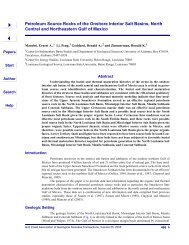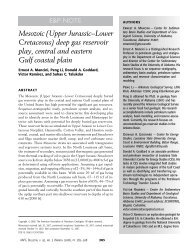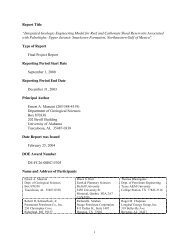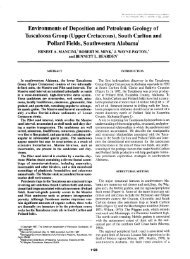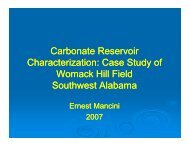Part 4 - Berg - Hughes Center
Part 4 - Berg - Hughes Center
Part 4 - Berg - Hughes Center
You also want an ePaper? Increase the reach of your titles
YUMPU automatically turns print PDFs into web optimized ePapers that Google loves.
Across northern Louisiana in the producing fields of Bienville, Richland, Franklin,<br />
Tensas and Concordia Parishes, the Tuscaloosa consists of fine- to coarse-grained quartz<br />
arenites and fossiliferous clays, ashy sands, red beds, gray shales, and minor chert gravels<br />
deposited in fluvial-deltaic to shallow marine environments. Generally, the Tuscaloosa is<br />
overlain by the shaly Eagle Ford Formation that averages approximately 100 ft in<br />
thickness (Lenert and Kidda, 1958; Morrow, 1958; Rogers, 1958). Production is from the<br />
basal sandstones of the lower Tuscaloosa where net porous sand ranges from 90 to 250 in<br />
thickness (Cullom et al., 1962). Depth to the top of the sandstone reservoirs across the<br />
region ranges from 2,400 to 9,700 ft. Production of 24º to 46º API gravity oil,<br />
condensate, and gas is derived from quality reservoirs with porosities of 25 to 30% and<br />
permeabilities ranging from 200 to 2,000 md.<br />
Austin Group<br />
Producing Parishes<br />
Caddo, Bossier, Webster,<br />
Claiborne, Union<br />
The basal sediments of the Austin Group were deposited over a truncated surface of<br />
the Tuscaloosa Group (Forgotson, 1958a). In north Louisiana, the Austin Group includes<br />
the Brownstown and Tokio formations, with a thickness that ranges from zero on the<br />
Monroe Uplift to over 2,000 ft in Central Louisiana (Cullom et al., 1962). These shallow<br />
marine deposits consist mainly of medium- to coarse-grained glauconitic carbonaceous<br />
and argillaceous sandstone and alternating chalky, shaly and silty units. Carbonates that<br />
replace the sands and shales to the south typically are chalk or marl and have poor<br />
definition on well logs. Ogier (1963) described the Tokio Formation as consisting of<br />
coarse, gray and brown crossbedded quartz and dark gray lignitic fossiliferous clay. In<br />
376




